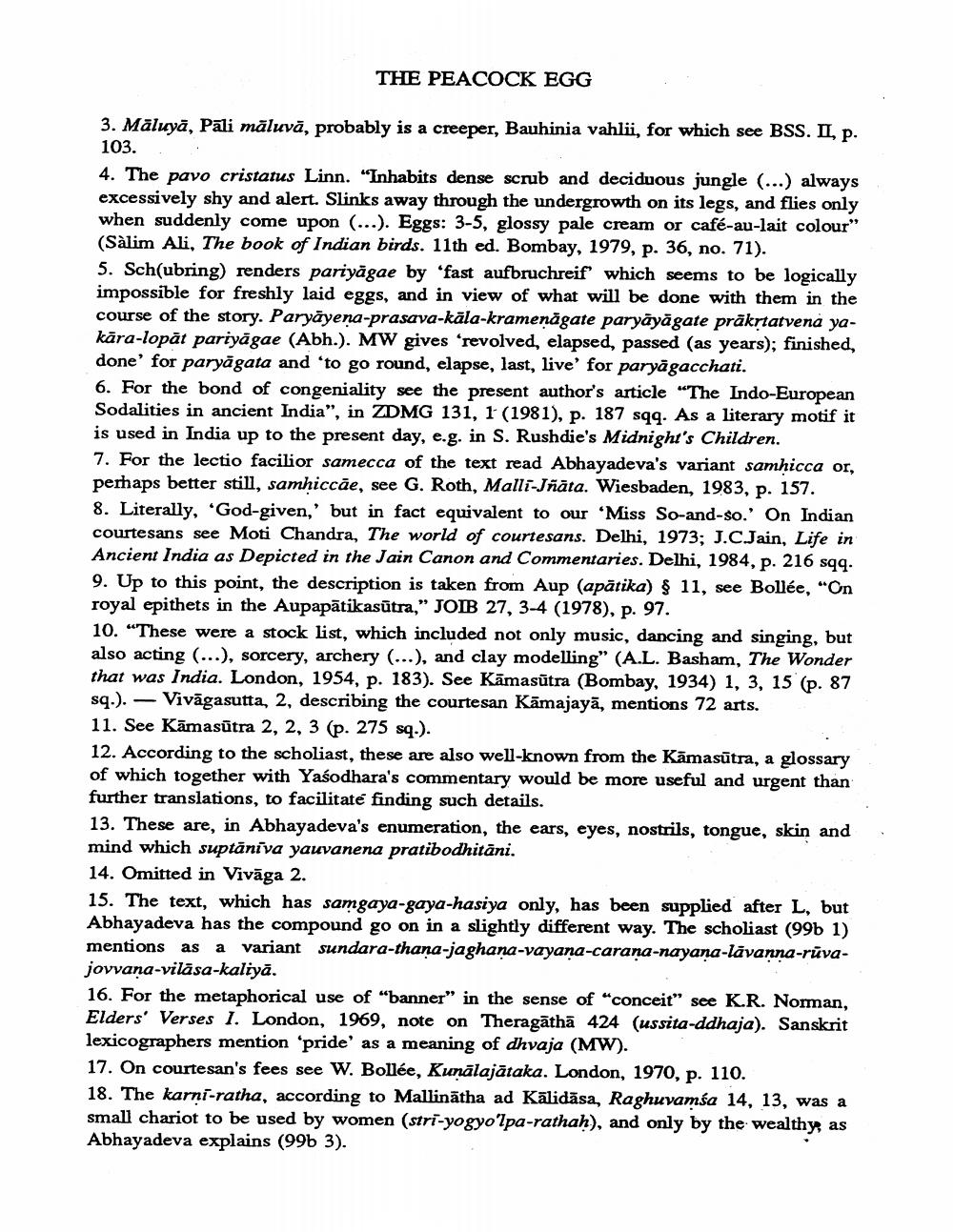________________
THE PEACOCK EGG
3. Māluyā, Pāli māluvā, probably is a creeper, Bauhinia vahlii, for which see BSS. II, p. 103.. . 4. The pavo cristatus Linn. "Inhabits dense scrub and deciduous jungle (...) always excessively shy and alert. Slinks away through the undergrowth on its legs, and flies only when suddenly come upon (...). Eggs: 3-5, glossy pale cream or café-au-lait colour" (Salim Ali, The book of Indian birds. 11th ed. Bombay, 1979, p. 36, no. 71). 5. Sch(ubring) renders pariyāgae by 'fast aufbruchreif which seems to be logically impossible for freshly laid eggs, and in view of what will be done with them in the course of the story. Paryāyena-prasava-kala-kramenāgate paryāyāgate prākstatvena yakara-lopāt pariyāgae (Abh.). MW gives 'revolved, elapsed, passed (as years); finished, done' for paryāgata and 'to go round, elapse, last, live' for paryāgacchati. 6. For the bond of congeniality see the present author's article "The Indo-European Sodalities in ancient India", in ZDMG 131, 1 (1981), p. 187 sqq. As a literary motif it is used in India up to the present day, e.g. in S. Rushdie's Midnight's Children. 7. For the lectio facilior samecca of the text read Abhayadeva's variant samhicca or, perhaps better still, samhiccāe, see G. Roth, Malli-Jñāta. Wiesbaden, 1983, p. 157. 8. Literally, 'God-given,' but in fact equivalent to our 'Miss So-and-so.' On Indian courtesans see Moti Chandra, The world of courtesans. Delhi, 1973; J.C.Jain, Life in Ancient India as Depicted in the Jain Canon and Commentaries. Delhi, 1984, p. 216 sqq. 9. Up to this point, the description is taken from Aup (apātika) § 11, see Bollée, "On royal epithets in the Aupapātikasūtra," JOIB 27, 3-4 (1978), p. 97. 10. “These were a stock list, which included not only music, dancing and singing, but also acting (...), sorcery, archery (...), and clay modelling" (A.L. Basham, The Wonder that was India. London, 1954, p. 183). See Kāmasūtra (Bombay, 1934) 1, 3, 15 (p. 87 sq.). — Vivāgasutta, 2, describing the courtesan Kāmajayā, mentions 72 arts. 11. See Kāmasūtra 2, 2, 3 (p. 275 sq.). 12. According to the scholiast, these are also well-known from the Kamasutra, a glossary of which together with Yaśodhara's commentary would be more useful and urgent than further translations, to facilitate finding such details. 13. These are, in Abhayadeva's enumeration, the ears, eyes, nostrils, tongue, skin and mind which suptāniva yauvanena pratibodhitāni. 14. Omitted in Vivāga 2. 15. The text, which has samgaya-gaya-hasiya only, has been supplied after L, but Abhayadeva has the compound go on in a slightly different way. The scholiast (99b 1) mentions as a variant sundara-thana-jaghana-vayana-carana-nayana-lavanna-ruvajovvana-vilāsa-kaliyā. 16. For the metaphorical use of "banner" in the sense of "conceit" see K.R. Norman, Elders' Verses I. London, 1969, note on Theragāthā 424 (ussita-ddhaja). Sanskrit lexicographers mention 'pride' as a meaning of dhvaja (MW). 17. On courtesan's fees see W. Bollée, Kunālajātaka. London, 1970, p. 110. 18. The karni-ratha, according to Mallinātha ad Kālidāsa, Raghuvamsa 14, 13, was a small chariot to be used by women (stri-yogyo'lpa-rathah), and only by the wealthy, as Abhayadeva explains (99b 3).




